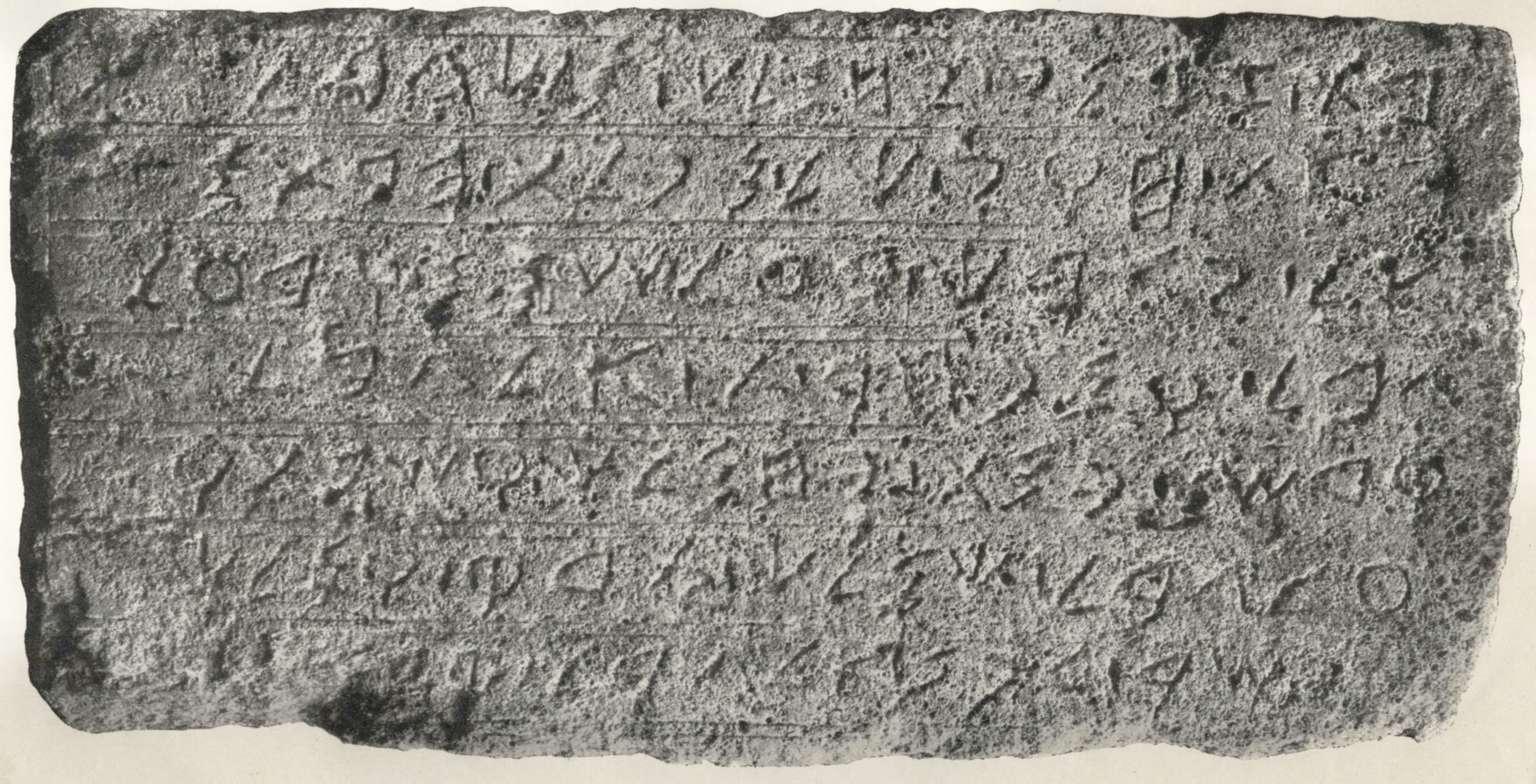Byblian Royal Inscriptions on:
[Wikipedia]
[Google]
[Amazon]
 The Byblian royal inscriptions are five inscriptions from
The Byblian royal inscriptions are five inscriptions from
Biblia Grammata: Documents et Recherches sur le Dévelopment de L'écriture en Phénicie
(Beyrouth: Direction des Antiquité, 1945): 146–151. Currently in the National Museum of Beirut. KAI 2 is the Byblos Necropolis graffito and KAI 3 are the Byblos bronze spatulas; neither contain names of royalty or other historical information.
File:Statue of Pharaoh Osorkon I-AO 9502-IMG 7652-white.jpg ,
The Dating of the Early Royal Byblian Phoenician Inscriptions: A Response to Benjamin Sass
" ''MAARAV'' 15 (2008): 57–93. * Benjamin Mazar, The Phoenician Inscriptions from Byblos and the Evolution of the Phoenician-Hebrew Alphabet, in The Early Biblical Period: Historical Studies (S. Ahituv and B. A. Levine, eds., Jerusalem: IES, 1986 riginal publication: 1946: 231–247. * William F. Albright, The Phoenician Inscriptions of the Tenth Century B.C. from Byblus, JAOS 67 (1947): 153–154. *
 The Byblian royal inscriptions are five inscriptions from
The Byblian royal inscriptions are five inscriptions from Byblos
Byblos ( ; ), also known as Jebeil, Jbeil or Jubayl (, Lebanese Arabic, locally ), is an ancient city in the Keserwan-Jbeil Governorate of Lebanon. The area is believed to have been first settled between 8800 and 7000BC and continuously inhabited ...
written in an early type of Phoenician script, in the order of some of the kings of Byblos
The Kings of Byblos were the rulers of Byblos, the ancient Phoenician city in what is now Lebanon.
Scholars have pieced together the fragmented list from various archaeological finds since the 19th century.
Early period
Some kings of Byblos from ...
, all of which were discovered in the early 20th century.
They constitute the largest corpus of lengthy Phoenician inscriptions from the area of the "Phoenician homeland"; it is the only major site in the region which has been excavated to pre-Hellenistic levels.
The five royal inscriptions
* The Ahiram Sarcophagus (KAI 1), discovered in 1923, together with two fragments of alabaster vases with the name ofRamesses II
Ramesses II (sometimes written Ramses or Rameses) (; , , ; ), commonly known as Ramesses the Great, was an Pharaoh, Egyptian pharaoh. He was the third ruler of the Nineteenth Dynasty of Egypt, Nineteenth Dynasty. Along with Thutmose III of th ...
. Currently in the National Museum of Beirut.
* The Yehimilk inscription (KAI 4) published in 1930. Currently in the museum of Byblos Castle.
* The Abiba’l inscription (KAI 5), on a throne on which a statue of Sheshonq I was placed, found in 1895, published in 1903. Currently in the Vorderasiatisches Museum Berlin.
* The Osorkon Bust
The Osorkon Bust, also known as the Eliba'l Inscription is a bust of Egyptian pharaoh Osorkon I, discovered in Byblos (in today's Lebanon) in the 19th century. Like the Tabnit sarcophagus from Sidon, it is decorated with two separate and unrelated ...
or Eliba'l Inscription (KAI 6), inscribed on a statue of Osorkon I
Sekhemkheperre Osorkon I was an ancient Egyptian pharaoh of the 22nd Dynasty. Osorkon's territory included much of the Levant.
The Osorkon Bust found at Byblos is one of the five Byblian royal inscriptions.
Biography
According to the stela of P ...
; known since 1881, published in 1925. Currently at the Louvre
The Louvre ( ), or the Louvre Museum ( ), is a national art museum in Paris, France, and one of the most famous museums in the world. It is located on the Rive Droite, Right Bank of the Seine in the city's 1st arrondissement of Paris, 1st arron ...
.
* The Safatba'al inscription
The Safatba'al inscription or the Shipitbaal inscription is a Phoenician inscription (KAI 7, TSSI III 9) found in Byblos in 1936, published in 1945.
It is at the National Museum of Beirut.
Text of the inscription
The inscription reads:
...
or the "Shipitbaal inscription" (KAI 7), found in Byblos in 1936, published in 1945. Maurice DunandBiblia Grammata: Documents et Recherches sur le Dévelopment de L'écriture en Phénicie
(Beyrouth: Direction des Antiquité, 1945): 146–151. Currently in the National Museum of Beirut. KAI 2 is the Byblos Necropolis graffito and KAI 3 are the Byblos bronze spatulas; neither contain names of royalty or other historical information.
Gallery
Osorkon Bust
The Osorkon Bust, also known as the Eliba'l Inscription is a bust of Egyptian pharaoh Osorkon I, discovered in Byblos (in today's Lebanon) in the 19th century. Like the Tabnit sarcophagus from Sidon, it is decorated with two separate and unrelated ...
inscription (Phoenician inscription on left and right of cartouche)
File:Sarcophagus with Phoenician writing 2.jpg, Ahiram sarcophagus inscription
File:Abiba’l Inscription, on a statue of Sheshonq I.jpg, Abiba’l inscription (Phoenician inscription more clearly visible on the archaeological copy)
File:Safatba'al Inscription.jpg, Safatba'al inscription
The Safatba'al inscription or the Shipitbaal inscription is a Phoenician inscription (KAI 7, TSSI III 9) found in Byblos in 1936, published in 1945.
It is at the National Museum of Beirut.
Text of the inscription
The inscription reads:
...
File:Inscription lapidaire de Shipitbaal - IXeme siècle avant JC - Byblos (Liban) - Musée national du Liban.jpg, Safatba'al inscription
File:Yehimilk Phoenician Inscription in the Byblos Castle Museum.png, Yehimilk inscription in the Byblos Castle Museum
Bibliography
* Christopher Rollston,The Dating of the Early Royal Byblian Phoenician Inscriptions: A Response to Benjamin Sass
" ''MAARAV'' 15 (2008): 57–93. * Benjamin Mazar, The Phoenician Inscriptions from Byblos and the Evolution of the Phoenician-Hebrew Alphabet, in The Early Biblical Period: Historical Studies (S. Ahituv and B. A. Levine, eds., Jerusalem: IES, 1986 riginal publication: 1946: 231–247. * William F. Albright, The Phoenician Inscriptions of the Tenth Century B.C. from Byblus, JAOS 67 (1947): 153–154. *
Notes
References
{{reflist, 2 11th-century BC inscriptions 10th-century BC inscriptions 9th-century BC inscriptions 8th-century BC inscriptions Byblos Phoenician inscriptions Kings of Byblos KAI inscriptions Archaeological artifacts Collections of museums in Lebanon Collection of the Louvre Inscriptions of Lebanon